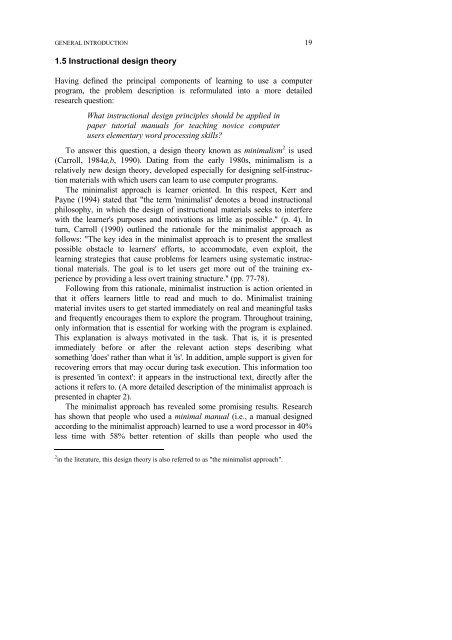MINIMALIST COMPUTER DOCUMENTATION - Universiteit Twente
MINIMALIST COMPUTER DOCUMENTATION - Universiteit Twente
MINIMALIST COMPUTER DOCUMENTATION - Universiteit Twente
You also want an ePaper? Increase the reach of your titles
YUMPU automatically turns print PDFs into web optimized ePapers that Google loves.
GENERAL INTRODUCTION<br />
1.5 Instructional design theory<br />
Having defined the principal components of learning to use a computer<br />
program, the problem description is reformulated into a more detailed<br />
research question:<br />
What instructional design principles should be applied in<br />
paper tutorial manuals for teaching novice computer<br />
users elementary word processing skills?<br />
To answer this question, a design theory known as minimalism 2 is used<br />
(Carroll, 1984a,b, 1990). Dating from the early 1980s, minimalism is a<br />
relatively new design theory, developed especially for designing self-instruction<br />
materials with which users can learn to use computer programs.<br />
The minimalist approach is learner oriented. In this respect, Kerr and<br />
Payne (1994) stated that "the term 'minimalist' denotes a broad instructional<br />
philosophy, in which the design of instructional materials seeks to interfere<br />
with the learner's purposes and motivations as little as possible." (p. 4). In<br />
turn, Carroll (1990) outlined the rationale for the minimalist approach as<br />
follows: "The key idea in the minimalist approach is to present the smallest<br />
possible obstacle to learners' efforts, to accommodate, even exploit, the<br />
learning strategies that cause problems for learners using systematic instructional<br />
materials. The goal is to let users get more out of the training experience<br />
by providing a less overt training structure." (pp. 77-78).<br />
Following from this rationale, minimalist instruction is action oriented in<br />
that it offers learners little to read and much to do. Minimalist training<br />
material invites users to get started immediately on real and meaningful tasks<br />
and frequently encourages them to explore the program. Throughout training,<br />
only information that is essential for working with the program is explained.<br />
This explanation is always motivated in the task. That is, it is presented<br />
immediately before or after the relevant action steps describing what<br />
something 'does' rather than what it 'is'. In addition, ample support is given for<br />
recovering errors that may occur during task execution. This information too<br />
is presented 'in context': it appears in the instructional text, directly after the<br />
actions it refers to. (A more detailed description of the minimalist approach is<br />
presented in chapter 2).<br />
The minimalist approach has revealed some promising results. Research<br />
has shown that people who used a minimal manual (i.e., a manual designed<br />
according to the minimalist approach) learned to use a word processor in 40%<br />
less time with 58% better retention of skills than people who used the<br />
2 in the literature, this design theory is also referred to as "the minimalist approach".<br />
19
















